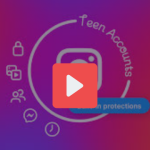We all love sharing photos of our kids online, but with the rise of deepfake technology, it’s important to be cautious. Deepfakes use AI to create fake videos or images that look real but aren’t. This technology has evolved quickly, and while it can be used for fun, it also has a darker side—especially when it comes to kids. Here’s what you need to know about deepfakes and why sharing your child’s images online could put them at risk.
Watch the video below
What Are Deepfakes?
Deepfakes are digital images or videos that have been altered using AI. They can change someone’s face or voice in a way that looks incredibly realistic. At first, deepfakes were mostly used for fun, like swapping faces with celebrities. But now, people can use this tech to create harmful or misleading content.
Why Should Parents Be Concerned?
Unfortunately, deepfake technology has started to target regular people too, including children. Here are some reasons why this is a growing issue for parents:
- Photos Can Be Misused: If you share a picture of your child online, someone can take it and use it to create a fake video or image.
- Cyberbullying: Deepfakes can be used to create embarrassing or harmful content about your child. This could lead to emotional distress if these fakes spread online.
- Inappropriate Content: The most worrying part is that predators could use deepfake technology to create inappropriate content using your child’s image.
How Easy Is It To Create a Deepfake Image Of Your Child?
Unfortunately, creating a deepfake image of your child is becoming increasingly easy due to advances in AI technology. Tools and apps designed to manipulate photos and videos are now widely accessible, many of them free or inexpensive to use.
In fact many of them are even advertised on social media platform. Recently, Facebook has been criticised for promoting such tools. Below is an example of an ad running on Facebook.

Recent Victims of Deepfakes
Even though deepfakes often target celebrities, everyday people, including children, are also at risk. Here are some examples:
- Celebrities: Stars like Emma Watson and Taylor Swifts have been victims of deepfakes, where their faces were used in inappropriate content.


- Private Individuals: In several cases, photos of everyday people, including children, have been taken from social media and used to create harmful deepfakes, spreading online without their consent.

“Schoolboys steal innocuous selfies from private Instagram accounts and create explicit images to share in the chat rooms, specifically to humiliate female classmates — or even teachers.” NDTV news
These examples show that deepfakes aren’t just a problem for celebrities—anyone’s images can be misused, including your child’s.
Why You Should Limit Sharing Your Child’s Photos Online
Here are some important reasons to think twice before posting pictures of your child online:
1. You Lose Control of the Image
Once a photo is posted, it’s nearly impossible to control where it goes. Even if your account is private, images can be shared, copied, or altered by others.
2. Deepfake Risks Are Real
Deepfakes are getting more realistic and easier to create. Even an innocent picture of your child can be manipulated into something harmful.
3. Protecting Their Future Privacy
When you share images online, you’re building a digital trail for your child that they might not want when they’re older. Keeping their online presence low helps protect their privacy long-term.
4. Facial Recognition Risks
Many websites use facial recognition to track individuals. By posting images of your child, you’re making it easier for systems to store and use their facial data, which could be exploited.
How to Protect Your Child from Deepfake Risks
While it’s hard to eliminate the risk completely, here are some tips to keep your child safe from deepfake dangers:
1. Limit Public Sharing
Try to avoid posting photos of your child in public spaces online. If you do post, adjust your privacy settings so only trusted friends and family can see the images.
2. Think Before You Post
Before sharing, ask yourself if it’s necessary. Does this image reveal personal info about where your child lives, goes to school, or their daily routine?
3. Use Tools to Track Images
You can use tools like Google Images or FaceCheck.id to search the web for photos of your child, helping you spot if any have been misused.
4. Teach Your Kids About Online Privacy
As your child gets older, explain the risks of sharing personal information or photos online and teach them how to stay safe.
5. Stay Updated on Technology
Keep yourself informed about deepfake technology and other online risks. This way, you can take the right steps to protect your family.
Final Thoughts: Keeping Your Child Safe Online
Deepfake technology is making the online world more complicated, especially for parents trying to protect their kids. While sharing photos online can seem harmless, it’s important to consider the risks that come with it, including the possibility of your child’s images being used in deepfakes. By being more cautious about what you share and staying informed about new digital dangers, you can help keep your child’s privacy safe in today’s digital world.






